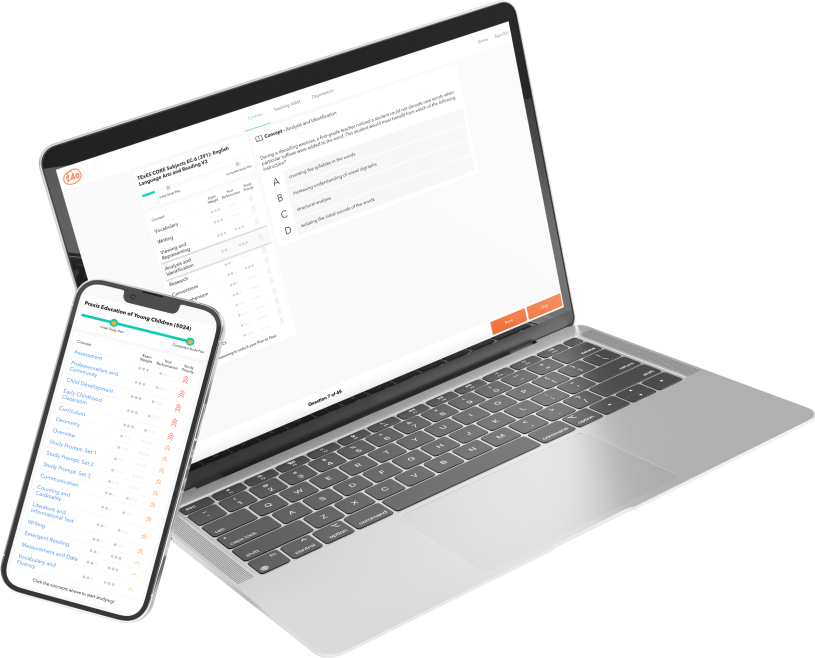Welcome to the Praxis® Teaching Reading: Elementary Practice Test and Prep Guide! We’ve created this free resource to prepare you specifically for the 5205 exam. We’ll go over the key concepts you’ll need to know to pass your test.
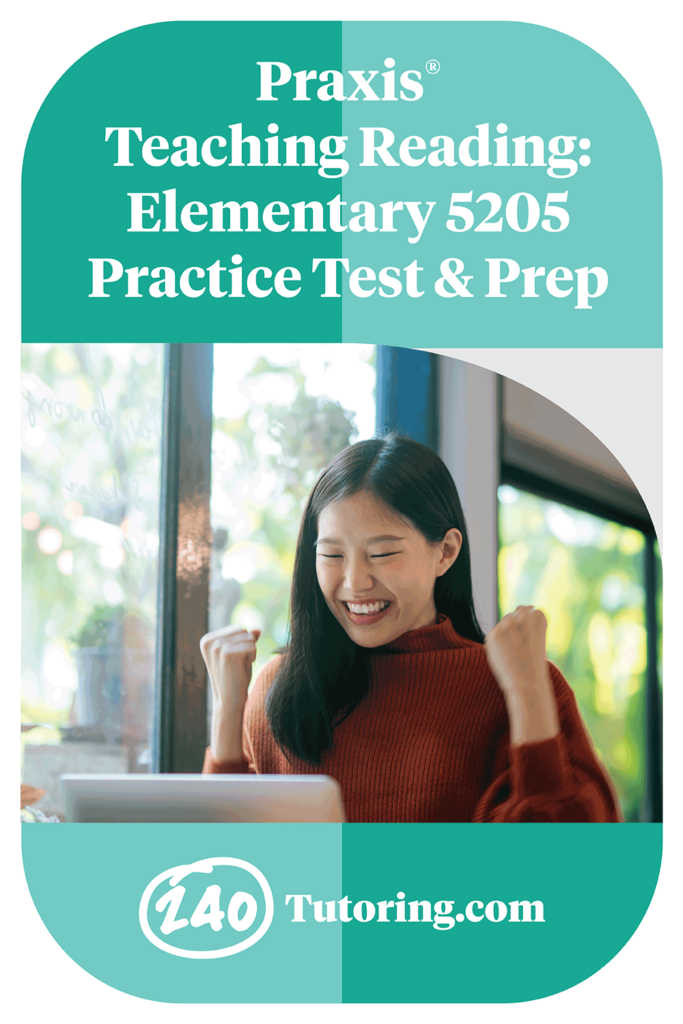 While this free guide outlines the categories found on the exam, our paid Praxis® Teaching Reading 5205 Study Guide covers EVERY concept you need to know and is set up to ensure your success! Our online Praxis® 5205 Study Guide provides test-aligned study material using interactive aids, videos, flashcards, quizzes, and practice tests.
While this free guide outlines the categories found on the exam, our paid Praxis® Teaching Reading 5205 Study Guide covers EVERY concept you need to know and is set up to ensure your success! Our online Praxis® 5205 Study Guide provides test-aligned study material using interactive aids, videos, flashcards, quizzes, and practice tests.
Will I pass using this free article?
Will I pass using your paid study guide?
If you use this overview guide and research the key concepts on the Praxis 5205 on your own, it’s possible you will pass, but why take that chance? With our paid study guide, we guarantee you will pass.
Not ready to start studying yet? That’s OK. Keep reading, and when you’re ready take our free Praxis 5205 practice test.
In this article, we will cover:
- Praxis 5205 Test Information
- Praxis 5205 Category 1: Phonological and Phonemic Awareness Including Emergent Literacy
- Praxis 5205 Category 2: Phonics and Decoding
- Praxis 5205 Category 3: Vocabulary and Fluency
- Praxis 5205 Category 4: Comprehension of Literary and Informational Text
- Praxis 5205 Category 5: Writing
- Praxis 5205 Category 6: Assessment and Instructional Decision Making
Praxis 5205 Test Information Overview:
The Praxis Teaching Reading: Elementary exam assesses the knowledge and skills necessary to support the reading instruction of kindergarten through sixth-grade students, including the science of reading and the five essential components (phonemic awareness, phonics, vocabulary, fluency, and comprehension) as well as writing instruction.
Format:
This Praxis II assessment is made up of six content categories.
| Content Category | Approximate Percentage of Exam |
| 1. Phonological and Phonemic Awareness including Emergent Literacy | 11% |
| 2. Phonics and Decoding | 15% |
| 3. Vocabulary and Fluency | 18% |
| 4. Comprehension of Literary and informational Text | 18% |
| 5. Writing | 13% |
| 6. Assessment and Instructional Decision Making | 25% |
Each of the first five categories contains multiple-choice questions. There are 90 multiple-choice questions in total. Categories 3 and 4 are weighted slightly more than the others, so they will have a few more questions each.
Category 6 is different because it includes three constructed-response questions (CRQs). These are free-response questions that ask you to apply your knowledge of teaching reading to specific scenarios. This category makes up 25 percent of your total score. Answering constructed-response questions can be intimidating, but they don’t have to be! Make sure to read through to category 6, where we walk you through how to tackle them.
Cost: $156
Time Limit: 2.5 hours
Scoring: The score range for the Praxis 5205 is 100-200. A passing score is 159.
Praxis 5205 Category 1: Phonological and Phonemic Awareness Including Emergent Literacy
There are lots of foundational skills involved in this first category. Overall, this is the stage in which your youngest students begin their journey as readers. Here are a few of the most important concepts to know.
Teachers need to build children’s language skills. You’ll need to be familiar with both types of language that need to be developed. Receptive language is a child’s ability to understand what they hear, and expressive language is a child’s ability to convey a message to others.
Parents, educators, and other caregivers can help foster these skills by doing things like reading and retelling stories, reciting nursery rhymes and modeling correct speech.
As students build those language skills, they will need to understand how print and speech are related. This connection can be modeled by reading from oversized books, pointing to the words as you read, and labeling items in the classroom.
One of the biggest concepts you’ll likely see on the Teaching Reading: Elementary test is the difference between phonological and phonemic awareness. Phonemic awareness is a skill under the “umbrella” of phonological awareness.
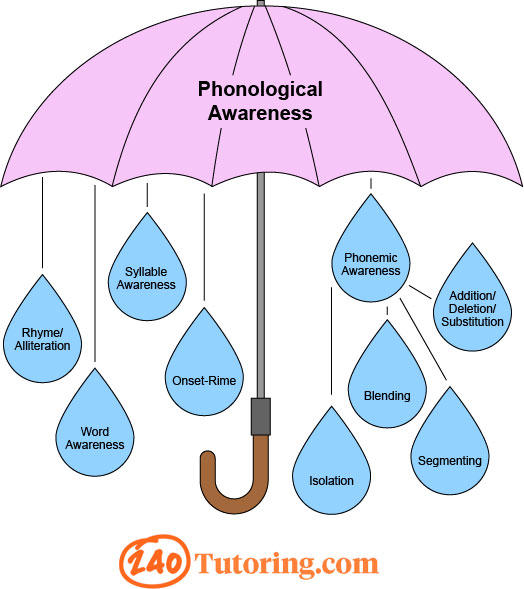
Phonological awareness covers the ability to recognize individual phonemes, syllables, and words. Phonemic awareness is the ability to hear and use individual units of sounds, or phonemes.
Questions on the Praxis 5205 exam may involve strategies used to teach phonological and phonemic awareness skills. Our study guide has a thorough list, but a useful one to know is Elkonin boxes, or sound boxes.
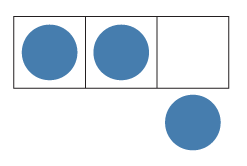
To target phonemic awareness, they can be used for isolating and segmenting phonemes. As students say a word, they move a token into a box for each sound they hear.
To target phonological awareness, they can be used to count syllables in a word. Another technique for helping students count syllables is to teach them to put their hand under their chin, say a word slowly, and count how many times their jaw drops down.
Praxis 5205 Category 2: Phonics and Decoding
This category is still mostly about younger children, but at this point, they’re ready to learn the core skills that they’ll use to read words on their own.
Essentially, phonics refers to the process of connecting the sounds of language – phonemes – to the corresponding written symbols – graphemes.
A big concept from this category to know for your exam is advanced phonics patterns. After students have learned single letter sounds, they will progress to more complex patterns. Here is a list of some of the most common to review.
- Consonant Blends – bl, pr
- Consonant Digraphs – sh, th
- Silent e – a_e, o_e
- Vowel digraphs – ai, ea
- Diphthongs – aw, oi
- R-controlled vowels – ar, er
- Inflectional Endings – ed, ing
You may get a few questions about syllabication. Students move from reading monosyllabic — or one syllable — words to multisyllabic words. There are six different types of syllables. You’ll need to be able to identify each one and know how to support students in learning them.
- Closed – syllable that has a short vowel sound spelled with one vowel letter and ends in one or more consonants; this is the most common spelling unit in English and accounts for almost 50% out of all the total syllables found in text
- hot, help, ad–mit, bas–ket
- Open – syllable spelled with a single vowel letter that ends with its long vowel sound
- me, a-gent, ro-bot, re-act
- Vowel-Consonant-e (VCe)– syllable with a long vowel sound made from one vowel + one consonant + silent e
- name, mice, com-plete, trom-bone
- Vowel Team (Digraphs and Diphthongs) – syllable with a long, short, or unique vowel sound that uses 2-4 letters to spell the vowel sound
- south, taught, aw-ful, team-mate
- Final Stable – syllable made with a consonant + l + silent e
- bu-gle, can-dle, cir-cle, tram-ple
- R-Controlled – syllable with a vowel followed by the letter r; the r changes the way the vowel is pronounced
- stir, gui-tar, mo-ther, or-ange
While much of phonics is about decoding, it’s important to know that some words can not be decoded.
Sight words are words that can’t be decoded because they don’t follow the typical rules for letter-sound correspondence, so students will need to memorize them.
High-frequency words may or may not be decodable. But since they’re so commonly used in texts, it’s helpful to memorize them.
You’ll need to know some strategies to help students memorize these words. The best answers are often multisensory approaches. An example of a tactile approach is having students make the words using play-doh or magnetic letters.
Praxis 5205 Category 3: Vocabulary and Fluency
Vocabulary comprises students’ ability to understand the words they’re reading. Often, vocabulary is learned indirectly, but on the Teaching Reading: Elementary exam, you’ll need to demonstrate your knowledge of how to teach new words directly.
There are many techniques for teaching new vocabulary, particularly academic vocabulary, but one strong example to have in your arsenal is the Frayer Model.
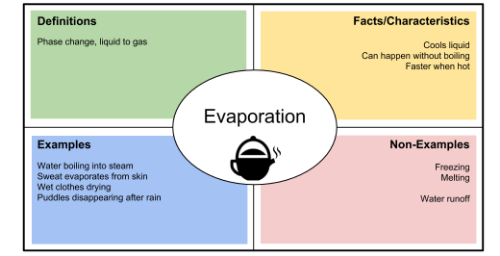
This method works because students are actively engaged as they complete each box with information about the word rather than just memorizing it.
Questions may also involve how to help your students determine the meaning of a new word while reading. The most common strategy is morphemic analysis (or structural analysis/word analysis). This refers to how words can be broken down into meaningful parts – morphemes – used to understanding the meaning of each part, then put together again to determine the meaning of the entire word. You may be asked to identify which word can be broken down using morphemic analysis. An example is “decaffeinated,” because you can break the word into the prefix “de,” the root “caffeine,” and the suffix “ate” to understand that it means something does not have caffeine in it.
Fluency consists of three components: accuracy, prosody, and speed.
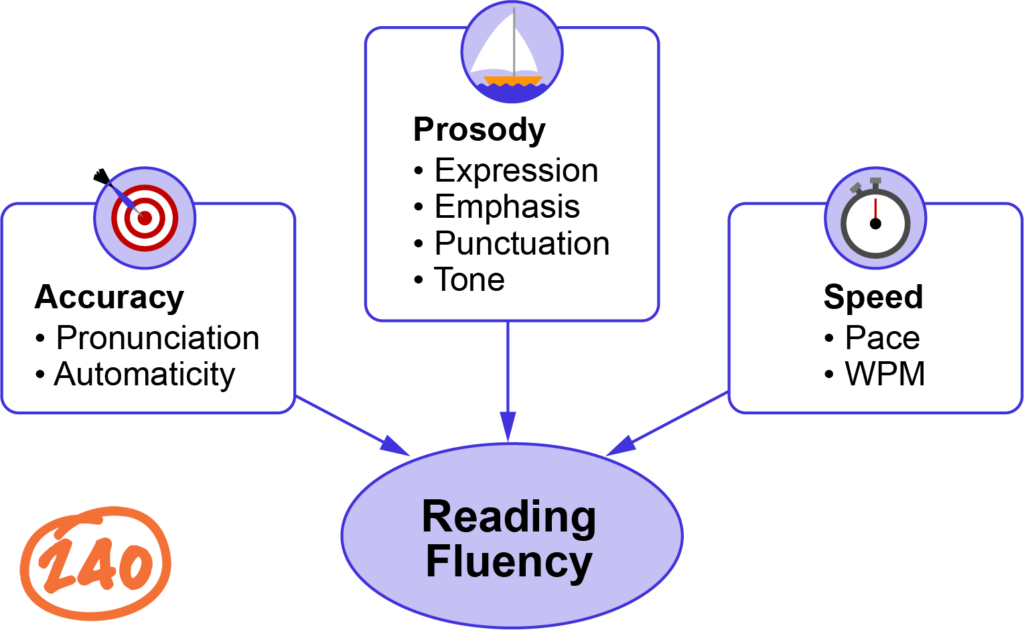
Questions from this category often involve strategies for building fluency, but knowing the appropriate strategies depends on which component of fluency a student is having difficulty with. But more often than not, it is a good idea to choose answers that involve students reading at their current level, with lots of opportunities to read out loud. Reader’s Theater, “whisper phones,” and having students record and listen to their own reading are common methods.
Praxis 5205 Category 4: Comprehension of Literary and Informational Text
It is important to know how to develop students’ comprehension so they move from learning to read to reading to learn.
You’ll need to be familiar with the three main types of comprehension: literal, inferential, and evaluative.
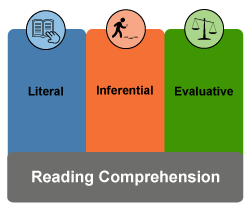
Here are some common strategies or types of questioning to develop each kind of comprehension.
| Literal Comprehension | Inferential Comprehension | Evaluative Comprehension |
| Summarizing | Recognizing cause and effect | Metacognitive skills |
| Identifying plot elements | Predicting | Forming opinions |
Another big topic that comes up on the teaching reading elementary exam is informational text, or nonfiction text. When answering questions about informational text, look for the choices that involve text features. Students need to learn how to effectively preview these features before reading and refer to them during and after reading.
Text Features
- Table of contents
- Headings
- Charts, graphs, and diagrams
- Index
- Glossary
Praxis 5205 Category 5: Writing
Because reading and writing go hand-in-hand, writing is included on the Teaching Reading: Elementary test. The writing category includes two topics: written expression and spelling and grammar. The one that comes up the most is written expression.
Under written expression, you’ll likely be asked about the stages of the writing process. They are prewriting, drafting, revising, editing, and publishing.
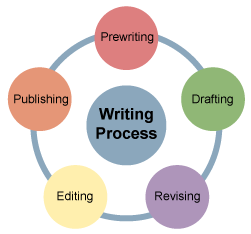
Teachers should provide explicit instruction in each step. Here are some common approaches to be knowledgeable about:
- Modeling — When introducing each stage, the teacher works through it first while students observe.
- Guided writing — Just like guided reading, the teacher provides small group instruction and feedback on a specific writing stage or skill.
- Conferencing — Individual students have the opportunity to review and discuss their writing with a classmate or the teacher.
Finally, to prepare for the spelling and grammar topic, be sure to review the stages of spelling development and how to develop students’ skills in each stage.
Praxis 5205 Category 6: Assessment and Instructional Decision Making
In this final category, you’ll be given three constructed-response questions (CRQs). Together they count for 25% of your total exam score. You already know the content you need from the first five categories. The CRQs allow you to demonstrate your knowledge by applying it to a specific teaching scenario that involves one of the first five categories (phonological and phonemic awareness, phonics, vocabulary and fluency, comprehension, or writing) or diverse learners, such as English learners or students with disabilities.
Each constructed-response question scenario will be accompanied by certain tasks for you to respond to. We recommend writing one or two paragraphs for each task. You should write concisely because you’ll only have a few minutes to respond to each one. So you don’t need to write an opening or closing paragraph; just get right to the point.
There are many possibilities, but here is a sample question and response to review.
Scenario:
Ms. Johnson’s 5th-grade class is taking part in an integrated social studies and reading lesson. Her class is an inclusion class, with 4 students identified as having a learning disability and prescribed an Individual Education Program (IEP). With a partner, students are asked to read an assigned article on the American Civil War, record the definitions of assigned vocabulary words in a graphic organizer, and summarize the article on a sentence strip.
Tasks:
- Identify and explain ONE strategy the teacher could use to teach unfamiliar vocabulary words to the entire class.
- Identify TWO strategies or supports Ms. Johnson can utilize to assist a student with a learning disability in completing this assignment. Explain the benefit of each strategy.
Sample Strong Response:
Task 1: To help students with unfamiliar vocabulary words, Ms. Johnson should help them build background knowledge about the time period. This can be done by showing the students pictures and video clips from the Civil War. With careful selection, most vocabulary words in the readings, such as “artillery” or “bayonet,” could be shown as well. Because students were not alive when the Civil War took place, they will benefit greatly from visual depictions of the time period. To maximize this strategy, it should take place before students read.
Task 2: First and foremost, Ms. Johnson should make sure she is following each student’s IEP for required accommodations. However, there are other strategies Ms. Johnson should implement to support her students with learning disabilities. The first is reducing the number of questions in a task. Instead of recording definitions of six words, this group of students could record three in the same amount of time. The students with disabilities would still record all the definitions, just over a longer amount of time. This makes the assignment more manageable for a student struggling with a learning difficulty.
The second strategy Ms. Johnson should implement with this group of students is highlighting. As they read, using specific highlighters for specific purposes could help students with disabilities stay on task. For example, they could highlight context clues to help with vocabulary words. Depending on the level of the student, they could be taught to highlight the beginning, middle, and end of the article to assist with the last part of the task, summarizing the article. Highlighting while reading helps students learn self-monitoring skills that make them independent readers.
This response completely and accurately answered both tasks. In the first task, it includes specific examples (like “bayonet” and “artillery”). In the second task, it clearly pointed out the benefits of each strategy (“This makes the assignment more manageable for a student struggling with a learning difficulty.” “Highlighting while reading helps students learn self-monitoring skills that make them independent readers.”) These aspects make it a high-level response!
The 240 Praxis 5205 Study Guide includes many more practice prompts and responses to give you the confidence you need to pass your exam.
Ready to start studying? Subscribe now to Praxis 5205
